Submitted by Gitie on 26 June, 2010 - 00:19
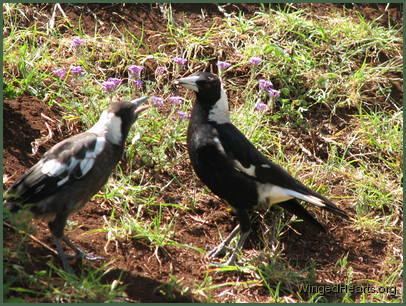 Today I'm going to show you some examples of the way birds use 'show and tell' as a way of communicating with us (and also each other).
Today I'm going to show you some examples of the way birds use 'show and tell' as a way of communicating with us (and also each other).
Consider the following two cases:
1. A group of magpies flies overhead headed towards the north. Our magpies sing out to them as they fly over. After a few chords they continue doing whatever activities had occupied them before.

Submitted by Gitie on 25 June, 2010 - 00:36
This is one of the first pictures I took of our birds back in 2001 with a film camera. (Any one remember those things that had to be handled carefully and in the dark?)
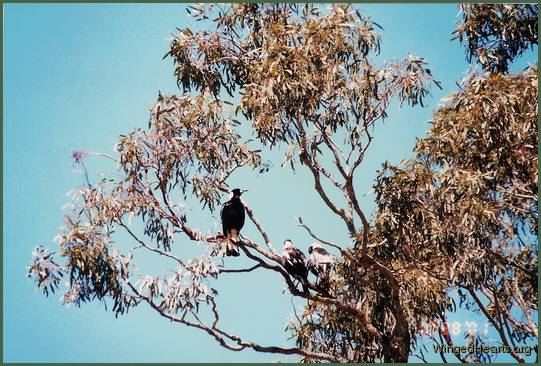
Here sitting on an old gum tree is Molly the mother magpie teaching juvis Maggie and Cindy to sing. They had the most brilliant voices and loved singing at top volume. This was during my early days of friendship with them.
In today's post we will explore tips 4-7 of getting to know your wild birds.

Submitted by Gitie on 24 June, 2010 - 01:00
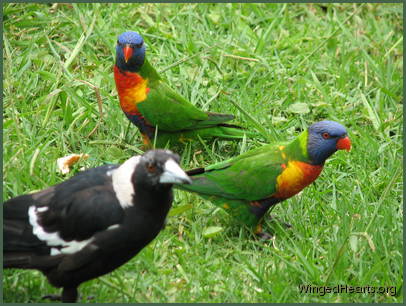 By now you will have a few friends whom you recognise and call by name. The next stage is to get o know more about your birds.
By now you will have a few friends whom you recognise and call by name. The next stage is to get o know more about your birds.
There are seven main points that you can follow to further develop your relationship with your new wild bird friends. These are:
1. Make Time For Regular Interaction
2. Learn More About The Species
3. Gain Insight's Into Your Individual Bird Friends
4. Listen for Cues
5. Notice Changes In their Behaviour
6. Keep a Daily Journal
7. Look for Wider Patterns and Stories

Submitted by Gitie on 23 June, 2010 - 00:15
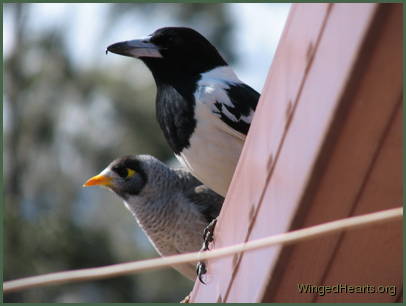 Now the birds are getting used to you taking an interest in them. They are beginning to create their own patterns of understanding your words and behaviour, based on the sound and tones of your words and also your actions and movements.
Now the birds are getting used to you taking an interest in them. They are beginning to create their own patterns of understanding your words and behaviour, based on the sound and tones of your words and also your actions and movements.
In part 1 yesterday we covered - 1. Talking to the birds and 2. Watching Their Response.
Every species and every bird in every species will take their own time to respond to you. Some of the bolder birds will start coming forward giving you the opportunity to observe them at close range.
At this point there are a few different things you can start doing.

Submitted by Gitie on 22 June, 2010 - 01:53
There's definitely a list of do's and don'ts when it comes to talking to birds. 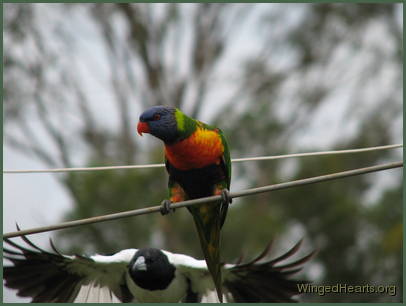 Wild birds have a big advantage over us, if they don't like what we're doing or saying they can fly away and avoid our company altogether. So in this case it is useful to understand the don'ts.
Wild birds have a big advantage over us, if they don't like what we're doing or saying they can fly away and avoid our company altogether. So in this case it is useful to understand the don'ts.
Birds scare easily - so the very first point is - Take care not to frighten the bird. This is surprisingly not as obvious as it seems. We humans get excited and enthusiastic and in our eagerness to make friends we sometimes don't give the birds enough time to get to know us.
Friendship is a two-way street and we have give the bird the time and opportunity to observe us as well. In the beginning, the bird will scare easily. Their reflexes and inherent instinct is to escape at the very slightest movement in the shadow or flutter of one's sleeve or dress in the wind, or the vibration on the ground when we walk. This is not due to a direct response to us per se. But birds are tuned to avoiding danger from other predatory birds, cats and other animals that prey on them. Even when they know us well, there will be times when they will just fly off and you'll be left wondering what on earth you did to frighten them! Don't be offended when that happens, and it will happen many times.

Pages

 Today I'm going to show you some examples of the way birds use 'show and tell' as a way of communicating with us (and also each other).
Today I'm going to show you some examples of the way birds use 'show and tell' as a way of communicating with us (and also each other).
 By now you will have a few friends whom you recognise and call by name. The next stage is to get o know more about your birds.
By now you will have a few friends whom you recognise and call by name. The next stage is to get o know more about your birds.  Now the birds are getting used to you taking an interest in them. They are beginning to create their own patterns of understanding your words and behaviour, based on the sound and tones of your words and also your actions and movements.
Now the birds are getting used to you taking an interest in them. They are beginning to create their own patterns of understanding your words and behaviour, based on the sound and tones of your words and also your actions and movements. Wild birds have a big advantage over us, if they don't like what we're doing or saying they can fly away and avoid our company altogether. So in this case it is useful to understand the don'ts.
Wild birds have a big advantage over us, if they don't like what we're doing or saying they can fly away and avoid our company altogether. So in this case it is useful to understand the don'ts. 



